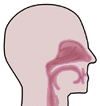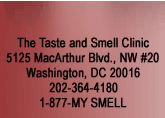  |
||
 |
December 2017Treatment of smell loss (hyposmia) — Agnostic pathology of biomarkers in patients with hyposmiaThere are multiple pathologies which biochemically initiate and perpetuate smell loss (hyposmia). These pathologies are non-neoplastic diseases and include viral-type infections, allergic rhinitis, traumatic head injuries, inhalational anesthesia and several other pathologies. We have attempted to evaluate specific biochemical parameters, manifested as biomarkers, which identify the pathology underlying these various causes of hyposmia. While each of these pathologies reflects widely different initiating events to cause hyposmia the biomarkers underlying these events are similar in each pathology. These biomarkers are found in nasal mucus, the biological fluid which maintains olfactory receptors. These biomarkers are decreased nasal mucus concentrations of cAMP, cGMP and sonic hedgehog. The mechanisms for these changes are similar across each of these pathologies since these biomarkers reflect diminished activity of these moieties which act as growth or transcription factors which stimulate stem cells in the olfactory epithelium to initiate growth and perpetuation of olfactory epithelial receptor cells. Similarities in these growth factor abnormalities across these multiple initiating pathological events are the basis for this agnostic determination of the biomarkers which induce hyposmia. Indeed, correction of these biochemical abnormalities with treatment with the phosphodiesterase inhibitor theophylline increases nasal mucus levels of each of these biomarkers in each pathology which thereby improves hyposmia in each pathological entity and establishes the agnostic character of these biomarkers. ReferenceHenkin RI, Levy LM, Fordyce A. Taste and smell function in chronic disease: A review of clinical and biochemical evaluation of taste and smell dysfunction in over 5000 patients at The Taste and Smell Clinic in Washington, DC. Am J Otolaryngol. 2013;34:477-489. |
|